This week’s Weekly includes my review of “Swarm” at the Fabric Workshop and Museum and short review in the Editors Choice section of the Listings on Alex Da Corte’s “Welcome Your Sorrows” at Black Floor. Here’s the link to the art page and the Editor’s choice page. And here’s Libby’s posts on Swarm and on Da Corte.
Global Swarming
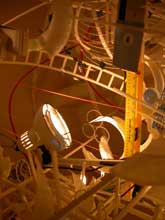
Good exhibits are like great conversations-energizing, enlightening and memorable. “Swarm” at the Fabric Workshop and Museum is such an exhibit. The show brings together 15 internationally known artists and two design teams to illustrate how the idea of swarming-the ebb and flow of group behavior, be it in hives, chat rooms or terrorist cells-is a fact of life artists have been flocking around for some time. (image is detail of Sarah Sze‘s installation in Swarm)
From algorithmically generated abstract projections to a banquette upholstered with a herd of stuffed animals, the art here doesn’t deal with the idea of the angry swarm, disturbed and on the attack. It’s mostly pacific in what it portrays or evokes-flowers, systems, birds, ants.
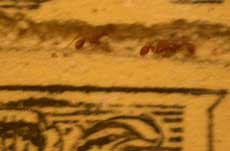
But at a time when war and terrorism call to mind angry human swarms and dysfunctional group behavior, it’s possible to read geopolitical subtexts about the social contract into almost every piece. Underneath the calm, beauty and orderliness of Sarah Sze‘s Rube Goldbergian Unravel, Yukinori Yanagi‘s ant colony in America and Fred Tomaselli‘s bucolic paintings is the implication that disorder and disaster are possible at any moment. (image is extreme detail of ants tunneling through Yanagi‘s ant colony on what looks like a dollar bill)
Swarms Entrapped
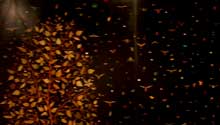
Fred Tomaselli‘s representational backyard landscapes in acrylic and resin are beautiful and iconic. But their subtext is the death of the environment. In Self-Annihilation Event in Hybrid Garden the artist placed his wet, sticky work in progress in his backyard at night and “captured” fireflies and moths on the surface, later working them into the painting, according to guest curator Ellen Lupton. Look close and you’ll see them, the swarm entrapped by resin and acrylic, both petrochemical byproducts. A piece about the death of nature at the hand of man could also be about the pretty trap that is art. It makes me think of art lovers swarming to the world’s big art fairs and getting stuck in the resin of their purchases.(image is detail of Tomaselli‘s piece.)

Shahzia Sikander and Michal Rovner use animation techniques to create the idea of masses (of people or objects) caught in a dancelike ebb and flow of behavior. Sikander, who paints in the style of Persian miniature paintings, animated portions of her SpiNN painting to look as though it’s being invaded by a swarm of black birds. But they’re not birds, and the whole thing is a comical lesson about perceived threat vs. real. (image is Curator Lupton standing before hive-like wallpaper designed by co-curator Abbott Miller for Knoll.)
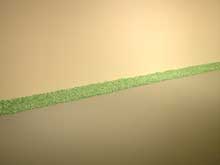
Rovner’s Seeds animation is projected in a petri dish. It shows a group of individuals-or perhaps one man in a business suit cloned about 100 times-reduced to the size of ants, moving in kaleidoscopic fashion into the center of the dish and then dispersing to the edge. The group behavior, nonproductive and orchestrated by a computer algorithm, is mesmerizing and darkly comic. It implies a world of manipulated humans unable to escape the herd. (image is Felix Gonzales-Torres candy give-away piece “Green” which has been laid out like a trail of insects along the wall.)
Trapped for Real
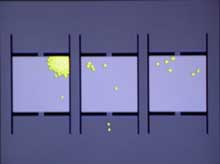
Yukinori Yanagi is famous for using live ants in his art. (see earlier image.) Iconic imagery like flags and money serve as the backdrop upon which his ant colonies march, making tunnels through sand. Yanagi’s work is about migration, globalism and borders. Watching the purposeful and unstoppable behavior of the ants encourages thoughts about how humans are similarly programmed. The tracks of our repeated behavior (filling up at the gas station, buying groceries, going to work) aren’t seen as tracks in the sand, but they’re equally unstoppable, and in some cases invasive to the earth. (image is a computer simulation of three rooms with crowds, all of which are in panic mode. On the left, the crowd defeats itself by herding together in a corner instead of filing out in an orderly fashion. The show has other computer simulations and videos describing insect behavior or cell behavior or randomized computer pixel behavior.)
Hives
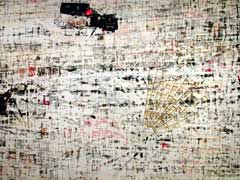
Trenton Doyle Hancock‘s paintings and drawings are obsessive celebrations of his labor and nature’s labors. His imagery uses a repeated hivelike object. Mark Bradford‘s works, on the other hand, are obliterations of the hive. What look like aerial maps of sprawling metropolises are covered with paint to create intricate gridlike erasures that feel like one swarm invading another. (image is one of two Bradford pieces in the show. You can see this and many other Swarm photos at my flickr site starting at about page 5.)
As long as war, technology, species endangerment, cloning, global warming, urban planning and sprawl make front-page news, the swarm will stay on the artist’s front burner.
“Swarm” through March 18. Fabric Workshop and Museum, 1315 Cherry St., fifth fl. 215.568.1111.
sketch
“Alex Da Corte: Welcome Your Sorrows”
Through Dec. 31. Black Floor Gallery, 319A N. 11th St., third fl.
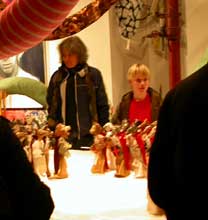
A sumptuous tableau of what looks like a Dungeons and Dragons-themed birthday party, Alex Da Corte‘s bittersweet “Welcome Your Sorrows” exhibit is like a snapshot of the moment before a storm—when everything’s beautiful, dark and clear. It’s a celebration of the end. The piece’s center is a tabletop display of two miniature armies facing off on a snow-white battlefield. The armies are royal, garbed in white satin and cloaked in red velvet. In keeping with the fairy tale atmosphere, the warriors have animal heads. Each side’s army is led by a lion, and the battalions are drawn from all classes of the animal, bird and reptile kingdoms. Streamers and plush snakes hover in the air. A forlorn horse that looks beaten sits nearby. But it’s the miniature armies with their beautiful ceramic animal heads, made by Nicholas Lenker, that give the broad-brush installation a delicacy and finesse that makes it a heartbreaker. They’re annihilation is at issue. This is you and me at the end. Both innocent and knowing, “Sorrows” is a remarkable first outing. Stay tuned for more in Da Corte’s upcoming solo show at Space 1026. (I loved the way this young boy was so captivated by Da Corte’s works. He felt like he was about the right size to get immersed into the tableau.)









